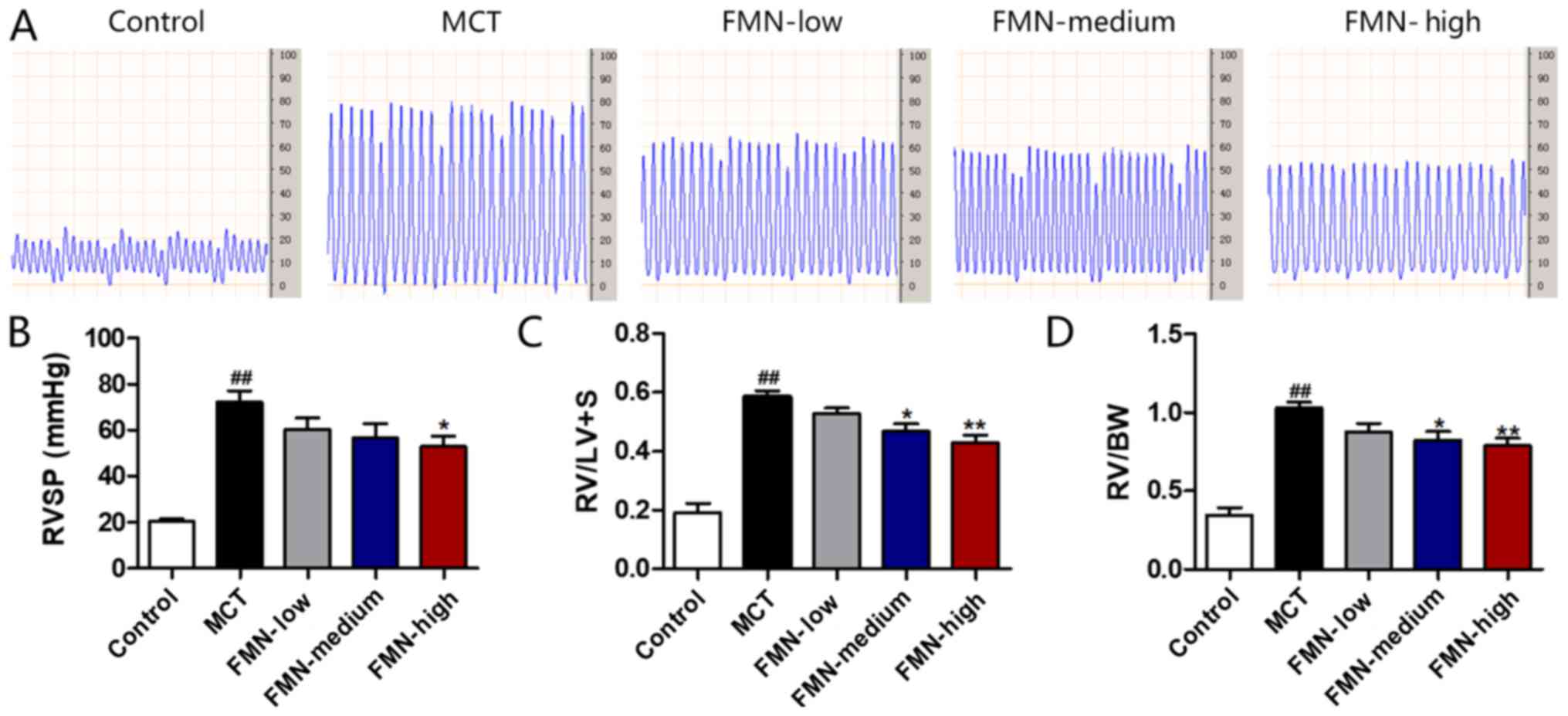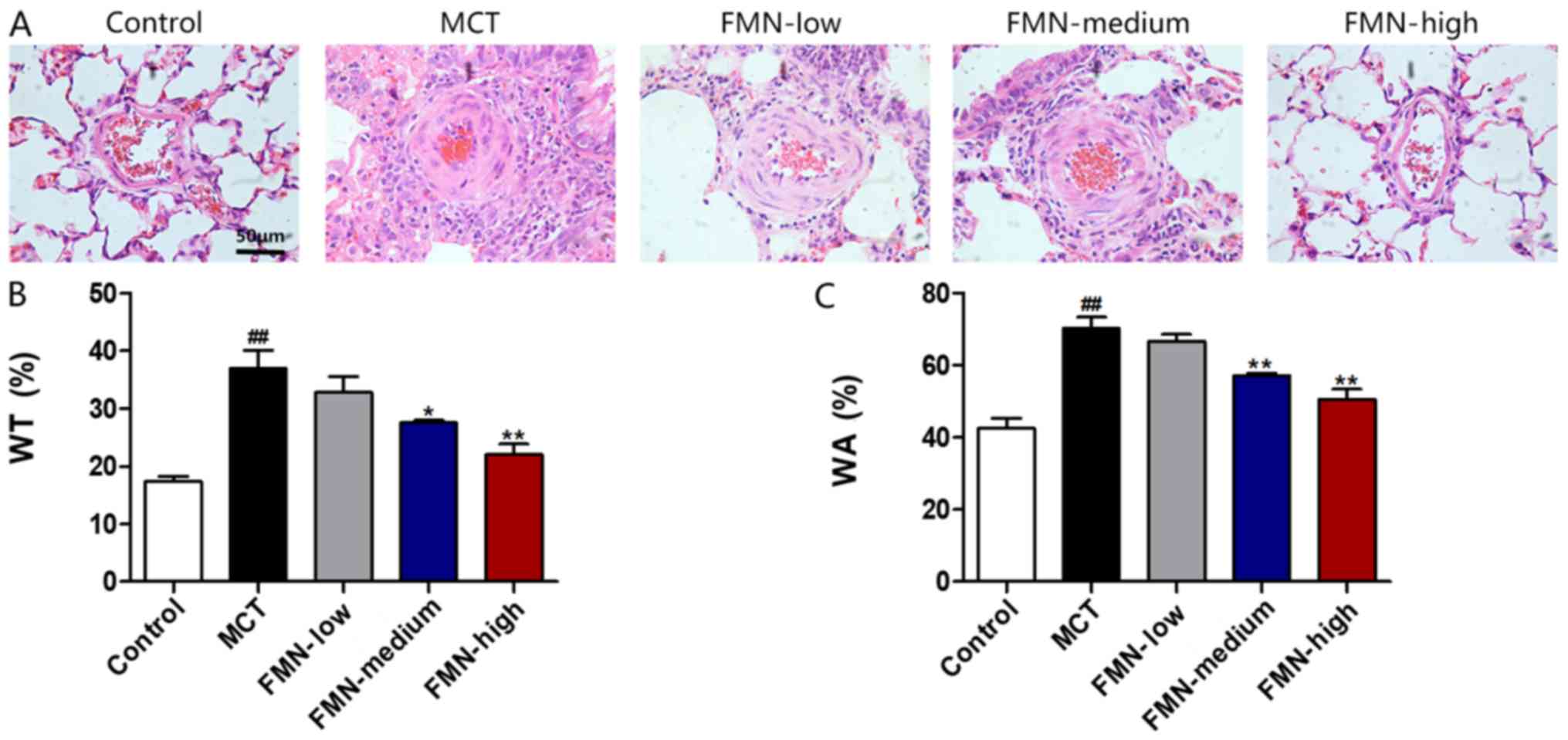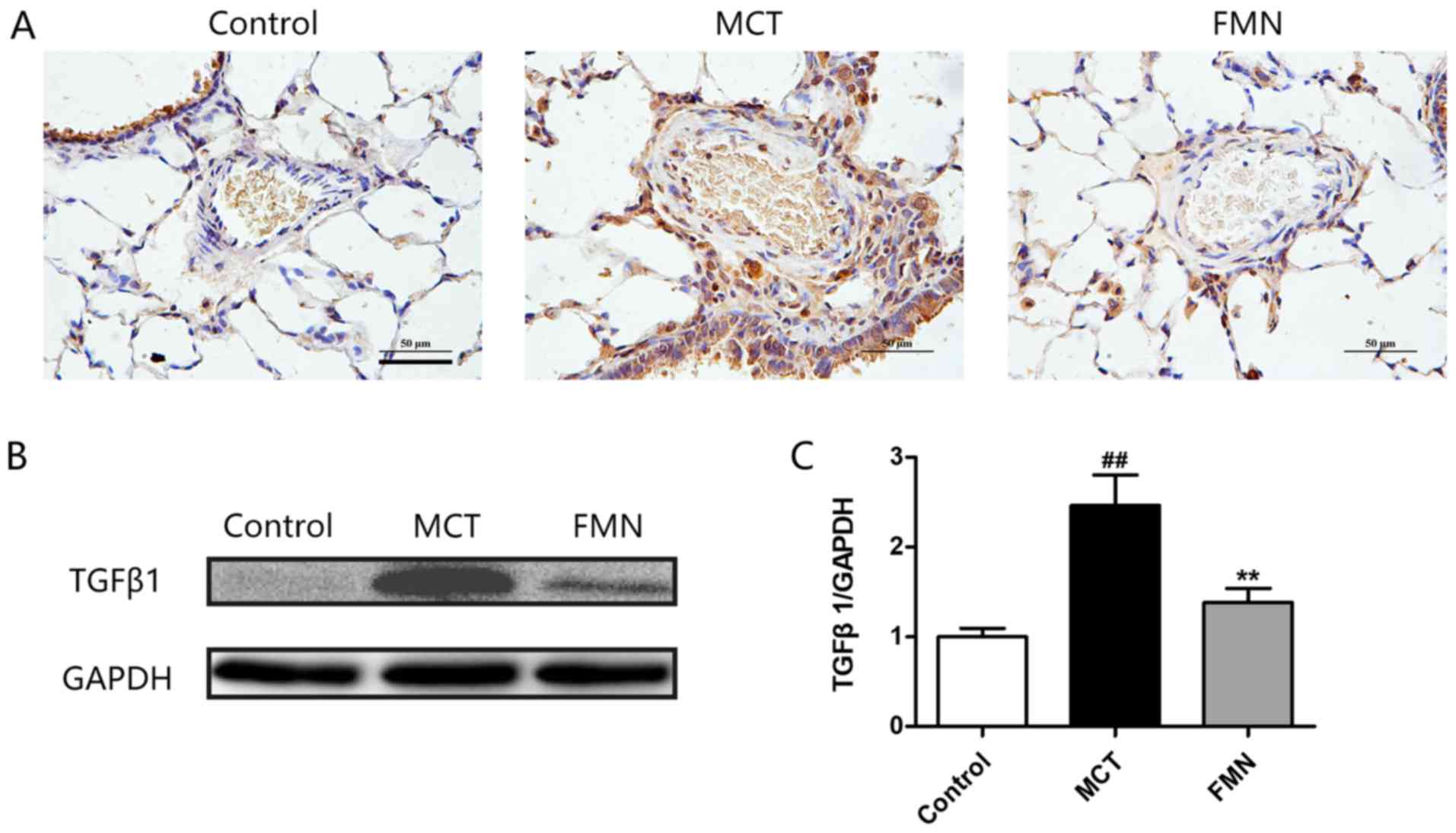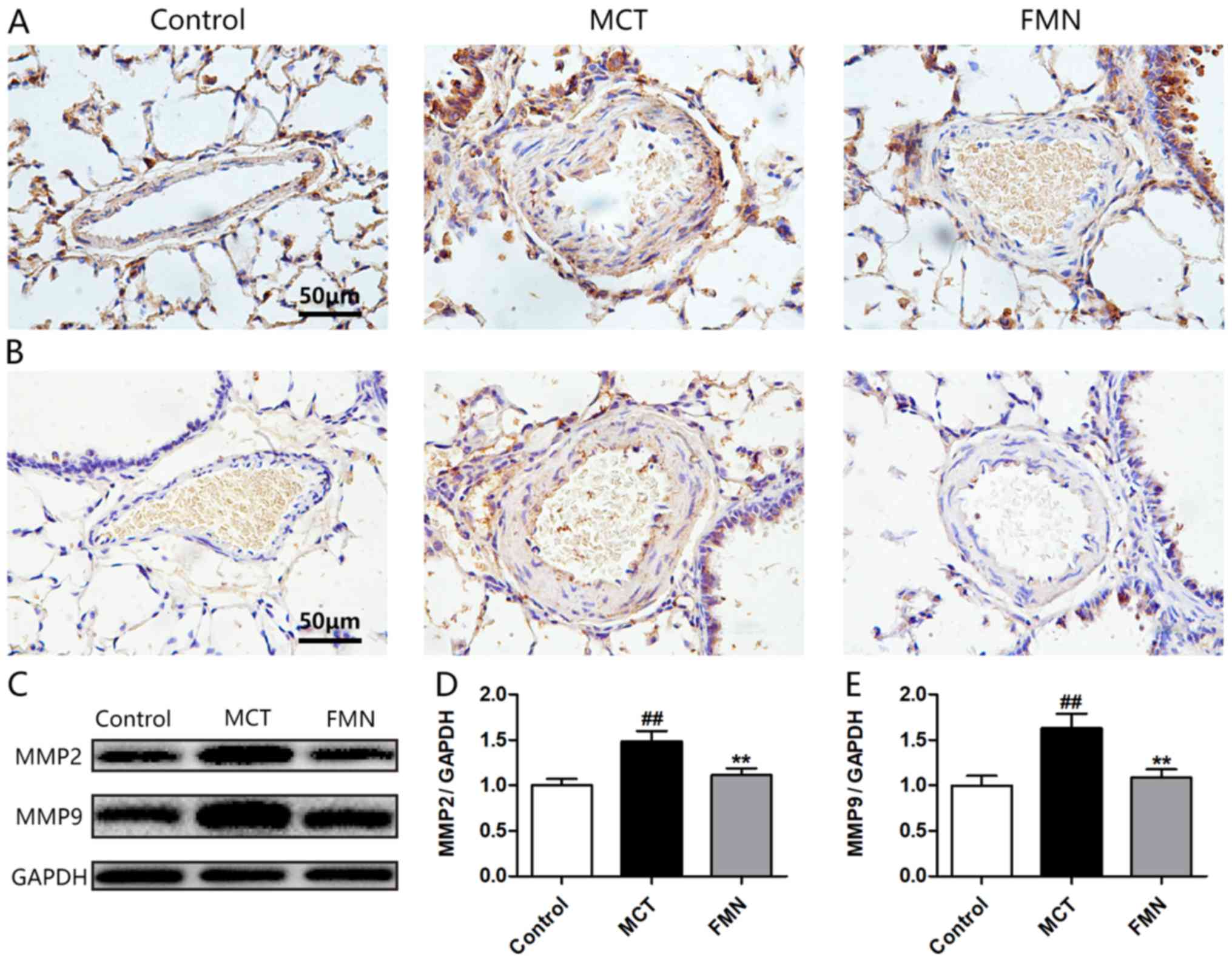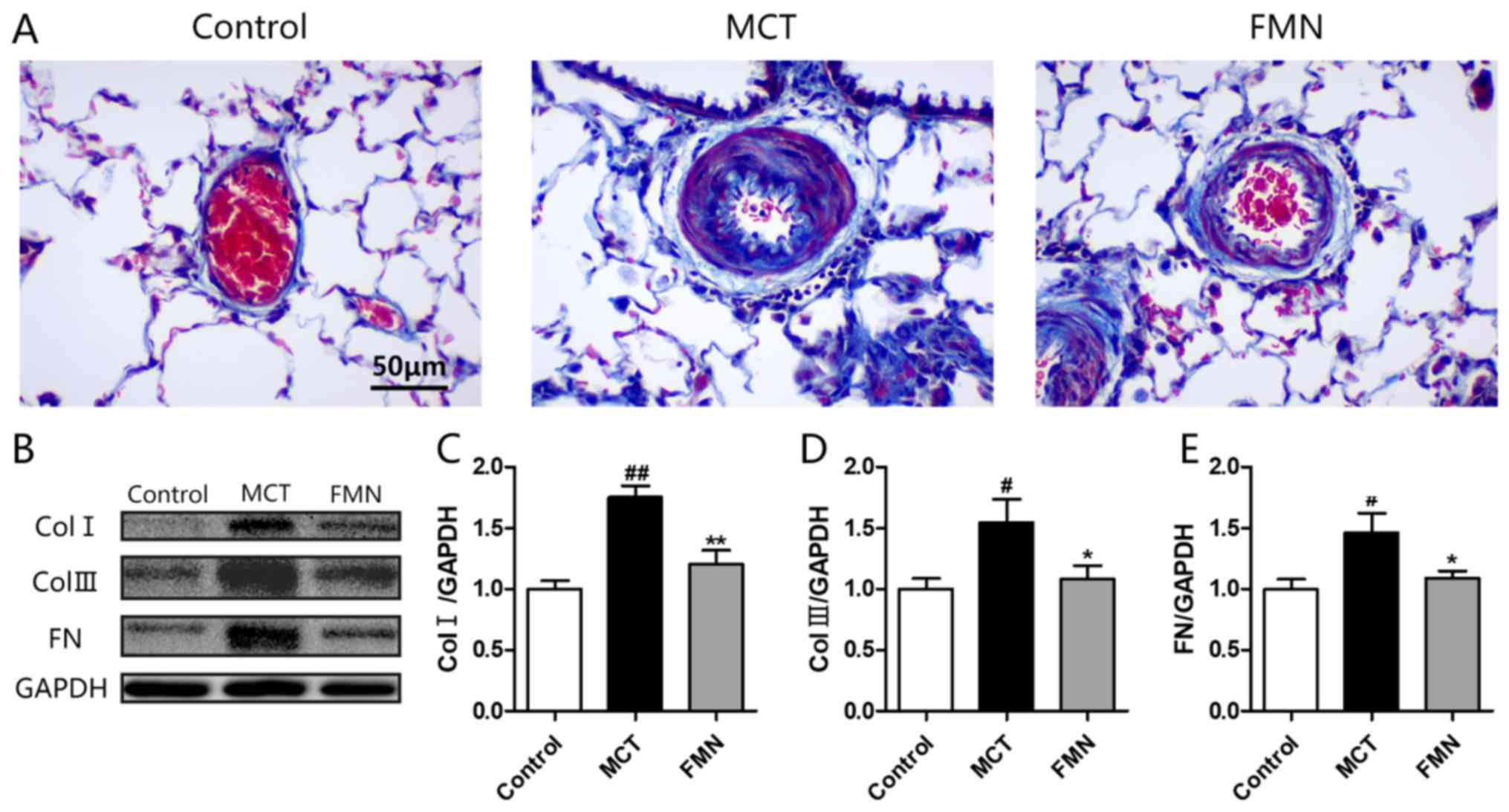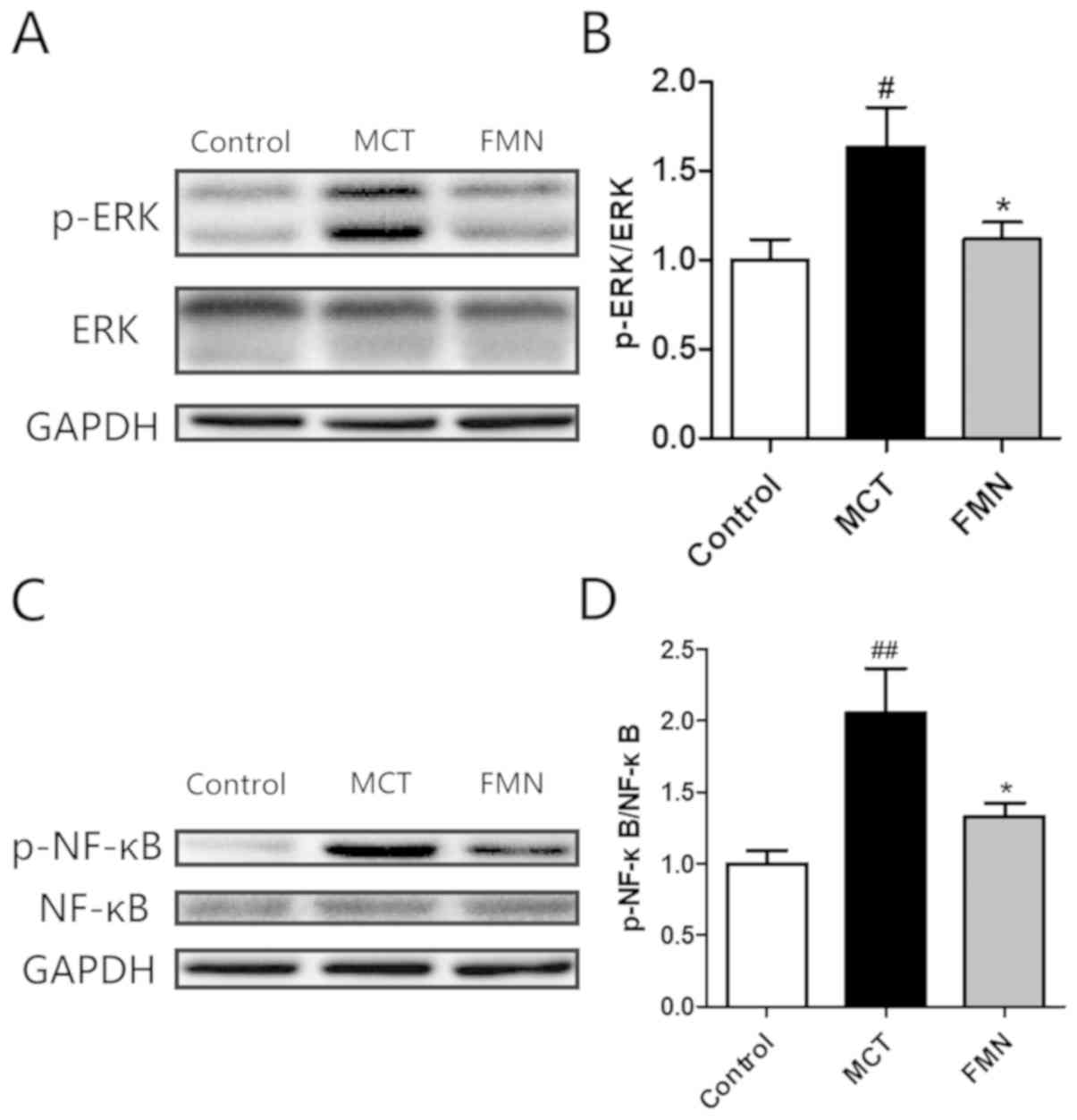|
1
|
De Jesus Perez VA: Molecular pathogenesis
and current pathology of pulmonary hypertension. Heart Fail Rev.
21:239–257. 2016. View Article : Google Scholar : PubMed/NCBI
|
|
2
|
Maciver DH, Adeniran I, Maciver IR, Revell
A and Zhang H: Physiological mechanisms of pulmonary hypertension.
Am Heart J. 180:1–11. 2016. View Article : Google Scholar : PubMed/NCBI
|
|
3
|
Montani D, Chaumais MC, Guignabert C,
Günther S, Girerd B, Jaïs X, Algalarrondo V, Price LC, Savale L,
Sitbon O, et al: Targeted therapies in pulmonary arterial
hypertension. Pharmacol Ther. 141:172–191. 2014. View Article : Google Scholar : PubMed/NCBI
|
|
4
|
Rabinovitch M, Guignabert C, Humbert M and
Nicolls MR: Inflammation and immunity in the pathogenesis of
pulmonary arterial hypertension. Circ Res. 115:165–175. 2014.
View Article : Google Scholar : PubMed/NCBI
|
|
5
|
Huertas A, Perros F, Tu L, Cohen-Kaminsky
S, Montani D, Dorfmuller P, Guignabert C and Humbert M: Immune
dysregulation and endothelial dysfunction in pulmonary arterial
hypertension: A complex interplay. Circulation. 129:1332–1340.
2014. View Article : Google Scholar : PubMed/NCBI
|
|
6
|
Thenappan T, Chan SY and Weir E.K: Role of
extracellular matrix in the pathogenesis of pulmonary arterial
hypertension. Am J Physiol Heart Circ Physiol. 315:H1322–H1331.
2018. View Article : Google Scholar : PubMed/NCBI
|
|
7
|
Li W, Guo A, Wang L, Kong Q, Wang R, Han L
and Zhao C: Expression of peptide fragments from proADM and
involvement of mitogen-activated protein kinase signaling pathways
in pulmonary remodeling induced by high pulmonary blood flow.
Congenit Anom (Kyoto). 56:28–34. 2016. View Article : Google Scholar : PubMed/NCBI
|
|
8
|
Li L, Wei C, Kim IK, Janssen-Heininger Y
and Gupta S: Inhibition of nuclear factor-κB in the lungs prevents
monocrotaline-induced pulmonary hypertension in mice. Hypertension.
63:1260–1269. 2014. View Article : Google Scholar : PubMed/NCBI
|
|
9
|
Tannenberg P and Tran-Lundmark K: The
extracellular matrix in early and advanced pulmonary arterial
hypertension. Am J Physiol Heart Circ Physiol. 315:H1684–H1686.
2018. View Article : Google Scholar : PubMed/NCBI
|
|
10
|
Eble JA and Niland S: The extracellular
matrix of blood vessels. Curr Pharm Des. 15:1385–1400. 2009.
View Article : Google Scholar : PubMed/NCBI
|
|
11
|
Lammers SR, Kao PH, Qi HJ, Hunter K,
Lanning C, Albietz J, Hofmeister S, Mecham R, Stenmark KR and
Shandas R: Changes in the structure-function relationship of
elastin and its impact on the proximal pulmonary arterial mechanics
of hypertensive calves. Am J Physiol Heart Circ Physiol.
295:H1451–H1459. 2008. View Article : Google Scholar : PubMed/NCBI
|
|
12
|
Ambalavanan N, Nicola T, Li P, Bulger A,
Murphy-Ullrich J, Oparil S and Chen YF: Role of matrix
metalloproteinase-2 in newborn mouse lungs under hypoxic
conditions. Pediatr Res. 63:26–32. 2008. View Article : Google Scholar : PubMed/NCBI
|
|
13
|
Novotná J and Herget J: Possible role of
matrix metalloproteinases in reconstruction of peripheral pulmonary
arteries induced by hypoxia. Physiol Res. 51:323–334.
2002.PubMed/NCBI
|
|
14
|
Chelladurai P, Seeger W and Pullamsetti
SS: Matrix metalloproteinases and their inhibitors in pulmonary
hypertension. Eur Respir J. 40:766–782. 2012. View Article : Google Scholar : PubMed/NCBI
|
|
15
|
Perrotta F, Nigro E, Mollica M,
Costigliola A, D'Agnano V, Daniele A, Bianco A and Guerra G:
Pulmonary hypertension and obesity: Focus on adiponectin. Int J Mol
Sci. 20:E9122019. View Article : Google Scholar : PubMed/NCBI
|
|
16
|
Perros F, Montani D, Dorfmuller P,
Durand-Gasselin I, Tcherakian C, Le Pavec J, Mazmanian M, Fadel E,
Mussot S, Mercier O, et al: Platelet-derived growth factor
expression and function in idiopathic pulmonary arterial
hypertension. Am J Respir Crit Care Med. 178:81–88. 2008.
View Article : Google Scholar : PubMed/NCBI
|
|
17
|
Krenn L and Paper DH: Inhibition of
angiogenesis and inflammation by an extract of red clover
(Trifolium pratense L.). Phytomedicine. 16:1083–1088. 2009.
View Article : Google Scholar : PubMed/NCBI
|
|
18
|
Zhang S, Tang X, Tian J, Li C, Zhang G,
Jiang W and Zhang Z: Cardioprotective effect of sulphonated
formononetin on acute myocardial infarction in rats. Basic Clin
Pharmacol Toxicol. 108:390–395. 2011. View Article : Google Scholar : PubMed/NCBI
|
|
19
|
Sun T, Wang J, Huang LH and Cao YX:
Antihypertensive effect of formononetin through regulating the
expressions of eNOS, 5-HT2A/1B receptors and α1-adrenoceptors in
spontaneously rat arteries. Eur J Pharmacol. 699:241–249. 2013.
View Article : Google Scholar : PubMed/NCBI
|
|
20
|
Jin YM, Xu TM, Zhao YH, Wang YC and Cui
MH: In vitro and in vivo anti-cancer activity of formononetin on
human cervical cancer cell line HeLa. Tumour Biol. 35:2279–2284.
2014. View Article : Google Scholar : PubMed/NCBI
|
|
21
|
Zhang X, Bi L, Ye Y and Chen J:
Formononetin induces apoptosis in PC-3 prostate cancer cells
through enhancing the Bax/Bcl-2 ratios and regulating the p38/Akt
pathway. Nutr Cancer. 66:656–661. 2014. View Article : Google Scholar : PubMed/NCBI
|
|
22
|
Liu Y, He J, Chen X, Li J, Shen M, Yu W,
Yang Y and Xiao Z: The proapoptotic effect of formononetin in human
osteosarcoma cells: involvement of inactivation of ERK and Akt
pathways. Cell Physiol Biochem. 34:637–645. 2014. View Article : Google Scholar : PubMed/NCBI
|
|
23
|
Huh JE, Seo DM, Baek YH, Choi DY, Park DS
and Lee JD: Biphasic positive effect of formononetin on metabolic
activity of human normal and osteoarthritic subchondral
osteoblasts. Int Immunopharmacol. 10:500–507. 2010. View Article : Google Scholar : PubMed/NCBI
|
|
24
|
Alauddin, Chaturvedi S, Malik MY, Azmi L,
Shukla I, Naseem Z, Rao C and Agarwal NK: Formononetin and
biochanin A protects against ritonavir induced hepatotoxicity via
modulation of NfκB/pAkt signaling molecules. Life Sci. 213:174–182.
2018. View Article : Google Scholar : PubMed/NCBI
|
|
25
|
Zhu N, Zhao X, Xiang Y, Ye S, Huang J, Hu
W, Lv L and Zeng C: Thymoquinone attenuates monocrotaline-induced
pulmonary artery hypertension via inhibiting pulmonary arterial
remodeling in rats. Int J Cardiol. 221:587–596. 2016. View Article : Google Scholar : PubMed/NCBI
|
|
26
|
Ichimura K, Matoba T, Koga JI, Nakano K,
Funamoto D, Tsutsui H and Egashira K: Nanoparticle-mediated
targeting of pitavastatin to small pulmonary arteries and
leukocytes by intravenous administration attenuates the progression
of monocrotaline-induced established pulmonary arterial
hypertension in rats. Int Heart J. 59:1432–1444. 2018. View Article : Google Scholar : PubMed/NCBI
|
|
27
|
Seimetz M, Parajuli N, Pichl A, Veit F,
Kwapiszewska G, Weisel FC, Milger K, Egemnazarov B, Turowska A,
Fuchs B, et al: Inducible NOS inhibition reverses
tobacco-smoke-induced emphysema and pulmonary hypertension in mice.
Cell. 147:293–305. 2011. View Article : Google Scholar : PubMed/NCBI
|
|
28
|
Wu F, Yao W, Yang J, Zhang M, Xu Y, Hao Y,
Yan L, Niu Y, Sun T, Yu J and Zhou R: Protective effects of
aloperin on monocroline-induced pulmonary hypertension via
regulation of Rho A/Rho kinsase pathway in rats. Biomed
Pharmacother. 95:1161–1168. 2017. View Article : Google Scholar : PubMed/NCBI
|
|
29
|
Li Q, Wang J, Zhu X, Zeng Z, Wu X, Xu Y,
Xie J and Yu J: Dihydromyricetin prevents monocrotaline-induced
pulmonary arterial hypertension in rats. Biomed Pharmacother.
96:825–833. 2017. View Article : Google Scholar : PubMed/NCBI
|
|
30
|
Schäfer M, Ivy DD, Abman SH, Stenmark K,
Browne LP, Barker AJ, Mitchell MB, Morgan GJ, Wilson N, Shah A, et
al: Differences in pulmonary arterial flow hemodynamics between
children and adults with pulmonary arterial hypertension as
assessed by 4D-flow CMR studies. Am J Physiol Heart Circ Physiol.
316:H1091–H1104. 2019. View Article : Google Scholar : PubMed/NCBI
|
|
31
|
Han X, Zhang Y, Zhou Z, Zhang X and Long
Y: Hydroxysafflor yellow A improves established
monocrotaline-induced pulmonary arterial hypertension in rats. J
Int Med Res. 44:569–584. 2016. View Article : Google Scholar : PubMed/NCBI
|
|
32
|
Bai Y, Wang HM, Liu M, Wang Y, Lian GC,
Zhang XH, Kang J and Wang HL: 4-Chloro-DL-phenylalanine protects
against monocrotaline-induced pulmonary vascular remodeling and
lung inflammation. Int J Mol Med. 33:372–382. 2014. View Article : Google Scholar
|
|
33
|
Long L, Crosby A, Yang X, Southwood M,
Upton PD, Kim DK and Morrell NW: Altered bone morphogenetic protein
and transforming growth factor-beta signaling in rat models of
pulmonary hypertension: Potential for activin receptor-like
kinase-5 inhibition in prevention and progression of disease.
Circulation. 119:566–576. 2009. View Article : Google Scholar : PubMed/NCBI
|
|
34
|
Hodges MM, Zgheib C, Xu J, Hu J, Dewberry
LC, Hilton SA, Allukian MW, Gorman JH III, Gorman RC and Liechty
KW: Differential expression of transforming growth factor-β1 is
associated with fetal regeneration after myocardial infarction. Ann
Thorac Surg. 108:59–66. 2019. View Article : Google Scholar : PubMed/NCBI
|
|
35
|
Tang PM, Nikolic-Paterson DJ and Lan HY:
Macrophages: Versatile players in renal inflammation and fibrosis.
Nat Rev Nephrol. 15:144–158. 2019. View Article : Google Scholar : PubMed/NCBI
|
|
36
|
Crosswhite P and Sun Z: Nitric oxide,
oxidative stress and inflammation in pulmonary arterial
hypertension. J Hypertens. 28:201–212. 2010. View Article : Google Scholar : PubMed/NCBI
|
|
37
|
Gao Y, Lu J, Zhang Y, Chen Y, Gu Z and
Jiang X: Baicalein attenuates bleomycin-induced pulmonary fibrosis
in rats through inhibition of miR-21. Pulm Pharmacol Ther.
26:649–654. 2013. View Article : Google Scholar : PubMed/NCBI
|
|
38
|
Mathew R: Inflammation and pulmonary
hypertension. Cardiol Rev. 18:67–72. 2010. View Article : Google Scholar : PubMed/NCBI
|
|
39
|
Lepetit H, Eddahibi S, Fadel E, Frisdal E,
Munaut C, Noel A, Humbert M, Adnot S, D'Ortho MP and Lafuma C:
Smooth muscle cell matrix metalloproteinases in idiopathic
pulmonary arterial hypertension. Eur Respir J. 25:834–842. 2005.
View Article : Google Scholar : PubMed/NCBI
|
|
40
|
Keller KE, Aga M, Bradley JM, Kelley MJ
and Acott TS: Extracellular matrix turnover and outflow resistance.
Exp Eye Res. 88:676–682. 2009. View Article : Google Scholar : PubMed/NCBI
|
|
41
|
Dorfmüller P, Perros F, Balabanian K and
Humbert M: Inflammation in pulmonary arterial hypertension. Eur
Respir J. 22:358–363. 2003. View Article : Google Scholar : PubMed/NCBI
|
|
42
|
Bai Y, Li ZX, Wang HL, Lian GC and Wang Y:
The protective effects of PCPA against monocrotaline-induced
pulmonary arterial hypertension are mediated through the
downregulation of NFAT-1 and NF-κB. Int J Mol Med. 40:155–163.
2017. View Article : Google Scholar : PubMed/NCBI
|
|
43
|
Kiss T and Kovacs K, Komocsi A, Tornyos A,
Zalan P, Sumegi B, Gallyas F Jr and Kovacs K: Novel mechanisms of
sildenafil in pulmonary hypertension involving
cytokines/chemokines, MAP kinases and Akt. PLoS One. 9:e1048902014.
View Article : Google Scholar : PubMed/NCBI
|
|
44
|
Kovacs L, Cao Y, Han W, Meadows L,
Kovacs-Kasa A, Kondrikov D, Verin AD, Barman SA, Dong Z, Huo Y and
Su Y: PFKFB3 in smooth muscle promotes vascular remodeling in
pulmonary arterial hypertension. Am J Respir Crit Care Med.
200:617–627. 2019. View Article : Google Scholar : PubMed/NCBI
|
|
45
|
Sawada H, Mitani Y, Maruyama J, Jiang BH,
Ikeyama Y, Dida FA, Yamamoto H, Imanaka-Yoshida K, Shimpo H,
Mizoguchi A, et al: A nuclear factor-kappaB inhibitor pyrrolidine
dithiocarbamate ameliorates pulmonary hypertension in rats. Chest.
132:1265–1274. 2007. View Article : Google Scholar : PubMed/NCBI
|
|
46
|
Price LC, Caramori G, Perros F, Meng C,
Gambaryan N, Dorfmuller P, Montani D, Casolari P, Zhu J, Dimopoulos
K, et al: Nuclear factor κ-B is activated in the pulmonary vessels
of patients with end-stage idiopathic pulmonary arterial
hypertension. PLoS One. 8:e754152013. View Article : Google Scholar : PubMed/NCBI
|
|
47
|
Wang AW, Song L, Miao J, Wang HX, Tian C,
Jiang X, Han QY, Yu L, Liu Y, Du J, et al: Baicalein attenuates
angiotensin II-induced cardiac remodeling via inhibition of
AKT/mTOR, ERK1/2, NF-κB, and calcineurin signaling pathways in
mice. Am J Hypertens. 28:518–526. 2015. View Article : Google Scholar : PubMed/NCBI
|
|
48
|
Morin C, Hiram R, Rousseau E, Blier PU and
Fortin S: Docosapentaenoic acid monoacylglyceride reduces
inflammation and vascular remodeling in experimental pulmonary
hypertension. Am J Physiol Heart Circ Physiol. 307:H574–H586. 2014.
View Article : Google Scholar : PubMed/NCBI
|
|
49
|
Peng X, Li HX, Shao HJ, Li GW, Sun J, Xi
YH, Li HZ, Wang XY, Wang LN, Bai SZ, et al: Involvement of
calcium-sensing receptors in hypoxia-induced vascular remodeling
and pulmonary hypertension by promoting phenotypic modulation of
small pulmonary arteries. Mol Cell Biochem. 396:87–98. 2014.
View Article : Google Scholar : PubMed/NCBI
|
|
50
|
Zhou XM, Wang GL, Wang XB, Liu L, Zhang Q,
Yin Y, Wang QY, Kang J and Hou G: GHK peptide inhibits
bleomycin-induced pulmonary fibrosis in mice by suppressing
TGFβ1/Smad-mediated epithelial-to-mesenchymal transition. Front
Pharmacol. 8:9042017. View Article : Google Scholar : PubMed/NCBI
|















